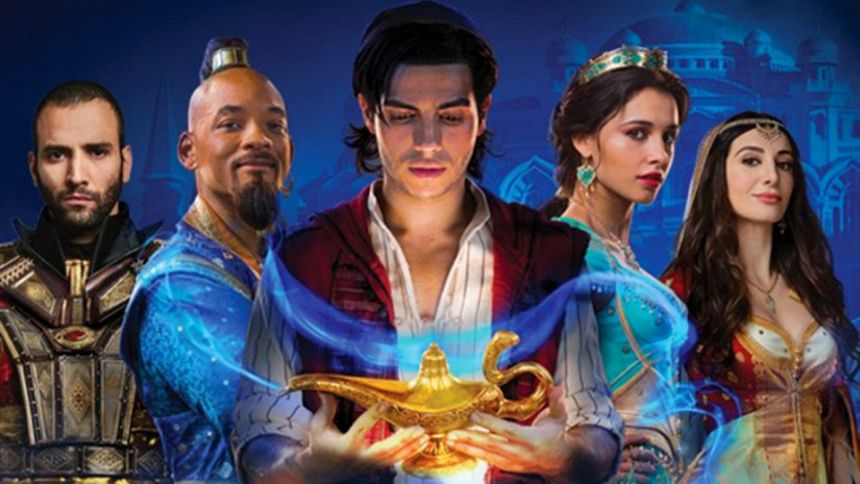Disney’s Aladdin and the appropriation of culture

Impelled largely by curiosity and not a little by the inner kid in me that is still in awe of fairy tales, I went to the cinema to watch a Disney film, a pleasure I strictly avoid.
Disney's Aladdin comes wrapped in Disney's latest gimmick, "live action." In movie parlance, this means that instead of animated cartoons, these movies feature real-life actors and animals, real or fantastic, which look so real that you can't tell the difference.
Don't get me wrong. It's not an awful movie. Disney's formidable production values, mind-boggling special effects and toe-tapping tunes that will cast such a spell on little children that their parents will rue the day they decided to take their kids to watch it.
Disney's goal is to create a product that will appeal to the maximum number of people in maximum number of places. Cultural nuance gets short shrift, and we end up with bland, homogenised cultural artefacts like Aladdin.
To give Disney its due, it has taken note of previous critiques. This effort appears to be culturally more sensitive. The character and the setting attempt a (flawed) feel of the Middle East (the original story is set in China, but never mind), though characters talk like Americans. Most actors are non-white.
Unfortunately, for all of Disney's good intentions, the film left me deeply disturbed because of the broader implications. I left the theatre with a disquieting feeling that a fairy tale had been seized, drained of any authentic cultural character and converted into a cultural condiment that is bland, homogenised and essentially rootless, not unlike other ham-handed American attempts. (I'm looking at you, Taco Bell. This American fast-food chain has gulled US customers into believing it sells Mexican food. This was apparently news to folks in Mexico, where it tried to open its restaurants. Mexicans, bless their hearts, were deeply unimpressed. Taco Bell had to close shop.)
With Aladdin, Disney plays fast and loose with the story. In the original story, the incident happens in China, and there are not one but two genies—the more powerful one with the lamp, and another one with a ring. Other major liberties are also taken.
I suppose I could live with that. But what really upsets me is the cultural ambiance of the film, or rather the lack of it. On closer look, for all the expense lavished on the film, instead of appearing culturally rooted, the film appears to take place in cultural la-la land. The costumes and sets represent less an actual geographical location than a kitschy cultural confection that exists only in the fevered imaginations of Disney. It's not an accident that it has a distinct Bollywood feel to it; Bollywood's stock-in-trade, after all, is creating a cultural ethos that is also a complete figment of the imagination.
Yet actual fairy tales are deeply invested in their specific location and culture. I grew up reading fairy tales from all over the world—Grimm's fairy tales had a whiff of Europe; the haunting, deeply affecting tales of Hans Christian Andersen had a Nordic feel. Russian fairy tales came in beautifully illustrated Soviet books. Then there were the stories of my own land, Thakurmar Jhuli (Grandma's bag of stories).
Now blaming Disney for leaching a fairy tale of its cultural essence is a bit pointless, like getting angry at a shark for chopping your arm off. It's just the nature of the beast.
Disney's goal is to create a product that will appeal to the maximum number of people in maximum number of places. Cultural nuance gets short shrift, and we end up with bland, homogenised cultural artefacts like Aladdin.
Not that Disney really cares. Why should it? The cash registers are ringing all over the world, and this is just the beginning. Expect a mind-boggling array of spin-offs to augment its bottom line—children's books, toys, costumes and last but not definitely the least, an Aladdin-themed ride in its amusement parks all over the world.
What's so depressing about it all is that diversity is as vital a need in culture as it is in ecology: a monoculture of the mind is asphyxiating for the spirit.
I am now less inclined to be sympathetic to the crisis affecting America's movie theatres. People are deserting cinemas in droves as streaming entertainment has become the new thing. Consider the hullaballoo over the Oscar-winning Mexican film Roma last year. The movie was produced by the streaming giant Netflix. Hollywood studios were livid, because streaming services like Netflix were eating their lunch.
Maybe that's not such a bad thing. As surely as summer brings along sunny days in the US, it brings with it a slew of fantastic, action-hero movies which have very little artistic or cerebral appeal to me.
Streaming services, it turns out, work on a different model. Instead of being obliged to dumb down their product to appeal to the maximum number of viewers, it can be selective and still manage to appeal to a huge cohort of discerning movie buffs. This allows it to be nimbler, and the results can be stunning.
This was brought home to me recently when I saw Photograph, an exquisite gem of a film starring the wonderful Nawazuddin Sheikh, and directed by Ritesh Batra, who also directed The Lunchbox, another gem. With Chekhovian grace, the film offers a deeply nuanced portrayal of an improbable love story that brings alive the diversity of Mumbai with exquisite grace. No surprise: It was produced by Amazon.
Can a culturally tethered, nuanced fairy tale movie be too far away? I wait with bated breath.
Ashfaque Swapan is a contributing editor for Siliconeer, a monthly periodical for South Asians in the United States.
Follow The Daily Star Opinion on Facebook for the latest opinions, commentaries and analyses by experts and professionals.
To contribute your article or letter to The Daily Star Opinion, see our guidelines for submission.

 For all latest news, follow The Daily Star's Google News channel.
For all latest news, follow The Daily Star's Google News channel. 



Comments